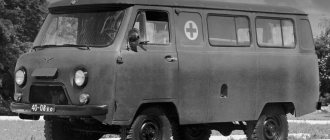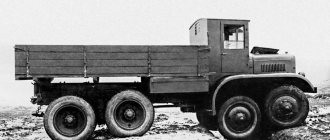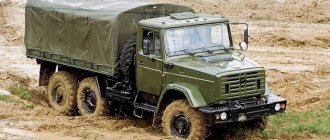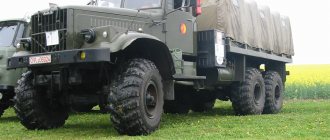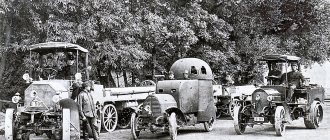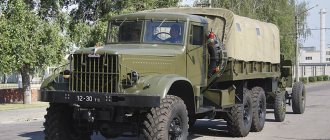KrAZ 257 is a heavy 3-axle off-road truck produced by the Kremenchug Automobile Plant (Ukraine). Serial production of the model lasted from 1965 to 1995. Over the 30 years of its existence, the technology has undergone several major modernizations and changes.
The development of the KrAZ 257 started in 1960. The model was considered as a replacement for the KrAZ 219. The car was not just a modernization of its predecessor, but a fundamentally new model with an advanced engine for that time (YaMZ-238) and a 5-speed gearbox. Typical problems inherent in earlier products of the Kremenchug Automobile Plant have been eliminated in the new product. The productivity of the KrAZ 257 increased by 30% compared to the KrAZ 219. With an increase in load capacity by 2000 kg, the weight was reduced by 300 kg. Serial production began in 1965 in parallel with the KrAZ 256 dump truck and the KrAZ 258 truck tractor.
In 1977, the series underwent a global modernization. The YaMZ-238 unit received serious modifications that increased its service life. The updated version, produced until 1995, was named KrAZ 257B1.
In 1985, the design of the car underwent further changes. Specialists from the Kremenchug Automobile Plant, together with employees of the Dnepropetrovsk Metallurgical Institute, mastered a new design of balancer suspension axles. Instead of a solid axle, the car received an axle made of a thick-walled pipe, which significantly increased the reliability of the car. The rigidity of the platform was increased by replacing hot-rolled sheets (3 mm) with cold-formed profiles (2.5 mm).
The KrAZ 257 was rightfully considered one of the most reliable vehicles in its class. The average service life before the first major overhaul reached 190,000 km. After repairs, the overhaul life was 152,000 km. Even having become seriously outdated, the KrAZ 257 continued to enjoy the trust of customers, and its production was finally completed only in 1995.
Device and characteristics
The vehicle was developed by the design bureau of the Kremenchug Automobile Plant as a successor to the KrAZ-219 truck, which was equipped with a 2-stroke diesel engine. The basis of the car is a steel ladder frame. The spars are made of channel bars with a constant cross-section. At the rear there is a towing device with 2-way shock absorption; on truck tractors, a rigidly fixed fork is installed.
The front axle is a forged 2-T beam mounted on leaf springs. The design uses hydraulic shock absorbers, and the steering rods are located at the rear of the axle. The steering is equipped with a hydraulic booster. The rear suspension consists of 2 longitudinal springs mounted on a balancer. The ends of the sheets move freely along spherical supports on the axle housings.
The power unit is a naturally-aspirated 8-cylinder diesel engine YaMZ-238, equipped with a mechanical high-pressure fuel pump. Power is 240 hp. at 2100 rpm. The engine is equipped with a dry clutch with 2 discs, equipped with an automatic slack adjuster. The trucks were equipped with a partially synchronized 5-speed gearbox.
To divide the power flow between the rear axles, a 2-speed transfer gearbox is used. The design of the unit has a center differential with the possibility of forced locking. The unit is controlled using a lever located in the driver’s cabin. Drive shafts with crosspieces on needle bearings go from the transfer case to the axles.
The drive axles are equipped with a gearbox with 2-stage torque transmission. The design of the unit uses a bevel pair and spur gears. Additionally, a bevel differential is installed. The truck uses drum brakes equipped with a pneumatic drive. A drum parking brake is installed at the output of the transfer gearbox. Additionally, there is a compression brake located inside the engine exhaust manifold.
Dimensions and technical characteristics of the KrAZ-257B flatbed truck:
- load capacity (on the highway) - 12000 kg;
- the weight of transported cargo in quarries is up to 20,000 kg;
- weight of the filled vehicle (without driver) - 10285 kg;
- highway speed - up to 68 km/h;
- length - 9640 mm;
- width (on the sides of the platform) - 2650 mm;
- height - 2670 mm;
- distance from the platform floor to the ground - 1495 mm;
- ground clearance - 290 mm;
- fuel supply - 330 l (2 cylindrical tanks).
The machines use a closed cabin with a wooden frame. Inside there is a sprung driver's seat and a sofa for 2 passengers. Windshields are installed in folding frames. The cabin is equipped with a heater, a pneumatically driven windshield wiper, and a ventilation hatch on the roof. The cargo platform has a metal base, the sides are made of wood.
After modernization in 1977, the vehicle began to be supplied by customers as the KrAZ-257-B1. The machines can be equipped with an autonomous heater in the engine cooling system. Individual circuits have been introduced into the brake drive, which has increased operational safety. The external lighting equipment has undergone modifications, and the reliability of components and assemblies has been increased.
A little history.
In 1954, the K-104 crane, based on the YaAZ-210 heavy truck, produced at the Yaroslavl Automobile Plant in the early fifties, emerged from the gates of the Odessa Crane-Building Plant. The leading designer of this crane was A.L. Tulchinsky. The K-104 crane became the first domestic serial truck crane with a diesel-electric drive. Its lifting capacity was 10 tons, and the 10-meter boom could be extended with an insert to 18 meters. Also, if necessary, the boom could be equipped with a jib 2.2 meters long. The crane could work with both a hook and a grab.
In the mid-fifties, the Odessa Crane Manufacturing Plant curtailed the production of automobile cranes, switching to the production of lifting equipment on self-propelled chassis. Therefore, the design documentation for the K-104 crane was transferred to the newly created Kamyshin truck crane plant in the city of Kamyshin in the Volgograd region. In December 1955, the first K-104 truck crane left the workshops of this enterprise.
Gradually, the Kamyshin plant modernizes its 10-ton crane and by 1960 prepares for production a new K-151 truck crane with a lifting capacity of 15 tons. However, this machine does not go into mass production. Further design work leads to an increase in the crane's lifting capacity to 16 tons. This new diesel-electric crane under the symbol K-162 begins to be mass-produced, first on the basis of the same KrAZ-219, and then on the KrAZ-257K. It has modifications: K-162M for the needs of the USSR Ministry of Defense, used in the Strategic Missile Forces for reloading missile equipment, and K-162S for work in the Far North. Serial production, organized in mid-1964, continued until the end of 1978. A total of 24,016 K-162 cranes of all modifications were manufactured.
In the late 1970s, a new model of truck crane on the KrAZ-257K1 chassis - KS-4561A - was developed at the Kamyshin Crane Plant, and in 1979 it began to be produced. Externally, it can be distinguished from the K-162 by the more “square” contours of the platform. The new crane received an index in accordance with the new standard adopted at the enterprises of the USSR Ministry of Construction and Dormash. The index is deciphered as follows: “KS” - self-propelled crane; first digit (4) - load capacity, 16 tons; second digit (5) — chassis type, automobile; third (6) - design of boom equipment, with rope suspension; fourth (1) - model number; letter (A) - first modification. The same cranes were produced on the KrAZ-250 chassis, under the designation KS-4561A-1. The new chassis features an improved driver's cabin for increased strength and durability. The machines were supplied with a standard 10 m lattice boom. The crane uses a modified generator with improved performance and cooling. The equipment allows work to be carried out in winds of up to 14 m/s (at a height of 10 m).
The KS-4561AM modification, used by the Strategic Missile Forces for reloading missile equipment, is a machine created taking into account the requirements of the USSR Ministry of Defense. The crane was shipped to the customer painted in a protective color and passed army acceptance. The design difference from the civilian version is an additional 7.5 kW electric motor to drive the auxiliary winch. The knot was used when installing an extension jib. It replaced the K-162 series cranes and since 1979 has been used for reloading missiles and loading 5P85 launchers of the S-300PS anti-aircraft missile system.
The KS-4561A truck crane was produced until 1989. The next truck crane model mastered by the Kamyshin plant, KS-4562, was mounted first on the KrAZ-250, and then on the KrAZ-65101. The carrying capacity of the KS-4562 was already 20 tons.
PURPOSE The automobile diesel-electric crane K-162 (KS-4561) is intended for mechanization of loading and unloading operations and installation operations. The main boom equipment is a non-retractable lattice boom. The set of replaceable working equipment includes three modifications of rigid non-retractable booms with and without a jib. In addition, the crane could operate as a grab with a capacity of 1.5 m3 and be equipped with USA-162 pile driver equipment for driving light piles 9-12 m long and weighing up to 3.0 tons into the ground using S-995 and S-996 diesel hammers. TECHNICAL DESCRIPTION The crane is mounted on the chassis of a KrAZ-219 (KrAZ-257K) vehicle. The chassis is equipped with a torsion stabilizer and folding outriggers, installed using a hydraulic drive. Roller slewing ring. The actuators are located in the cabin. An 8-cylinder 240-horsepower YaMZ-238 diesel engine is used to drive the crane units. The crane has an individual electric drive from a three-phase synchronous generator ECC5-82-4U2 with a power of 37.5 kW and a rated speed of 1500 rpm. The generator receives rotation from the chassis engine through the gearbox, driveshafts, and chassis transfer case. The power take-off is activated by a separate lever located in the driver's cab. The machine is equipped with an electrical distribution panel, which contains connectors for connecting external power.
An asynchronous motor with a power of 15 kW is used to drive the main winch. Changing the boom installation angle is carried out by a separate gearbox driven by a 7.5 kW motor. Current is transmitted from the generator through a slip ring located inside the slewing support mechanism. Changing the rotation speed of the engines is done by connecting resistances in the rotor circuit and adjusting the frequency (within the range of 37.5-50 Hz) and voltage (within the range of 320-400V). The winch motor is equipped with a special device that generates a constant magnetic field. When the device is turned on, electromagnetic braking of the rotor occurs, which ensures a slow lowering of the load. The function is used for loads up to 6 tons.
The crane controls are located in the driver's cabin. The working motion control system is controller-based and allows you to combine the raising (lowering) of a hook or boom with the rotation of the turntable. The cabin is equipped with a sun visor, a fan and an electric stove. The roof has folding glass. The cabin is detachable to ensure transportation by rail.
The crane allows you to work without installing additional outriggers; the load capacity with a 10 m boom is 4.4 tons. In this case, the vehicle can move at a speed of up to 5 km/h. Movement with a load is permitted only when the boom is positioned along the axis of the crane towards the rear axle. The machine allows you to lift loads from holes up to 3 m deep. On public roads, the crane unit without a load can move at a speed of 65 km/h.
The crane is equipped with both hook lift limiters, boom lift and load limiter OGB-2, automatic dangerous voltage alarm ASON, reach and load capacity indicators and a pendulum inclinometer.
History of the creation of KrAZ 257
Before studying the technical characteristics of the KrAZ 257 in more detail, it is necessary to study in more detail the history of the creation of the model and its features. This truck belongs to the category of heavy vehicles, and its design assumes the presence of three axles at once.
Its 6x4 wheel arrangement provides the necessary cross-country ability even in off-road conditions, which is especially important given the state of domestic roads. The car was produced at the Kremenchug plant from 1965 until 1995, which was due to consistently high demand for the model from consumers.
Over the course of 30 years of production, its design was periodically refined by the company's engineers, which led to the creation of several modifications. Thanks to this expansion of the model range, it is possible to select the appropriate truck to solve specific problems.
Modifications and additional equipment
If you look at numerous photos of a similar vehicle, you can conclude that there are several modifications of the car that have serious design differences. In addition, this model often uses additional equipment that can significantly expand its functionality.
The most popular modification remains the KrAZ 257S , which is a production model designed for operation in the Far North. Its main feature is the possibility of stable operation at temperatures down to -60 degrees, which makes it the best option for northern territories.
Among its other features, it seems that there is a heated windshield, as well as the presence of double glazing at the side doors. For better thermal insulation, the model uses additional seals and insulation, and a special heating device running on diesel is responsible for maintaining the required temperature.
The remaining design parts were also specially selected for operation in low temperature conditions, which made this tractor and other modifications one of the most reliable and successful.
Other modifications of the car are often found on sale:
- KrAZ-257 - basic on-board model;
- KrAZ-257Sh - a modification that provides for the presence of a chassis that can be used to install various additional equipment - tanks, specialized installations, concrete mixers and others;
- KrAZ-257S - modification of the base model, intended for operation in the northern regions;
- KrAZ 257 B1 - modification of the model with an increased service life, separate brake drives, as well as a special starter for the engine;
- KrAZ-257B1S is another name for the basic model, adapted for the northern territories.
Thanks to additional equipment, such models could act as dump trucks, truck tractors, truck cranes (KrAZ 257 k1), as well as motor vehicles. This vehicle was widely used in the Soviet Army for engineering and railway units.
Literature and sources
- Catalog of parts for KrAZ-256, KrAZ-256B, KrAZ-257 and KrAZ-258 vehicles. Kremenchug plant named after. 50th anniversary of Soviet Ukraine. M., “Mechanical Engineering”, 1971 - 248 pp.
- A. F. Lobzin. Design and operation of MAZ-500, KrAZ-257, Ural-375 vehicles. M., DOSAAF publishing house, 1977 - 304 pp.
- Temporary standards for the consumption of materials and tools for the repair and operation of KrAZ-257, KrAZ-255B, KrAZ-255V, KrAZ-255L vehicles. M., “Transport”, 1980 - 21 pp.
- Ilya Mikulin. The awkward Kremenchug hero // “Science and Technology”, No. 10 (89), 2013. pp. 64-68
The 171st military plant is a state enterprise of the military-industrial complex of Ukraine, which carries out diagnostics, repair and maintenance of special Soviet-made automotive equipment.
The 79th separate air assault brigade (Ukrainian 79-a okrema air assault brigade, 79 airborne assault brigade, military unit A0224) is an air assault brigade of the Air Assault Troops of the Armed Forces of Ukraine. Based in Nikolaev.
A mobile crane (Mobile crane, crane truck) is a jib-type crane that can be equipped with tower-boom equipment and moves without a load, without requiring special paths and whose stability is ensured by gravity.
Aerodrome equipment - means of preparation and maintenance of airfields, means of ground support for flights (maintenance) and special vehicles for commercial aircraft maintenance, otherwise - means of airfield technical support (ATO) - special automotive equipment, trailers and installations.
It can be specially designed for airfields or serial vehicles modified to perform specific tasks. At civil airports of the USSR, all airfield special vehicles were painted yellow, now they are painted white or simply bright, clearly visible colors. At military airfields, such equipment has a single-color or multi-color protective paint, but transverse or oblique red-white or yellow stripes are painted on the bumpers of the vehicles.
All vehicle traffic on airfields is strictly regulated by governing documents and is permitted in specially designated lanes for vehicles (appropriate markings are applied to the surface of the airfield), and is significantly different from traffic on public roads.
KS-6362 is a jib-type crane on pneumatic wheels with a lifting capacity of 40 tons. The crane was developed and tested under the symbol K-406. Serial production of the crane began in 1969 (under the designation KS-6362) and continued until the 1980s.
The cranes are designed to perform installation and loading and unloading operations with loads weighing up to 40 tons. Controller control makes it possible to simultaneously combine two different work operations.
KrAZ-219 is a Soviet heavy road three-axle truck, produced by the Kremenchug Automobile Plant (KrAZ) from 1959 to 1963. The body is a platform with opening side and rear sides. The cabin is three-seater, made of wood and metal.
KrAZ-250 is a family of heavy trucks produced by the Kremenchug Automobile Plant (KrAZ) from 1978 to 1992. It is a further development of the KrAZ-257 vehicle.
KrAZ-255B is a Soviet heavy all-terrain vehicle with a 6 × 6 wheel arrangement. Designed for transporting cargo and personnel on roads and off-road.
KrAZ-255L is a serial timber carrier developed on the basis of the KrAZ-255B design and produced in mass production by the Kremenchug Automobile Plant.
KrAZ-256B is a Soviet and Ukrainian heavy mining dump truck produced by the Kremenchug Automobile Plant. Designed for use on roads of the first and second categories, allowing an axle load of up to 10 tons, as well as for work in quarries.
KrAZ-258B is a Soviet truck tractor, mass-produced by the Kremenchug Automobile Plant.
Kremenchug Automobile Plant (KrAZ) (Ukrainian: Kremenchuk Automobile Plant) is a Soviet, then Ukrainian manufacturer and supplier of civil and special-purpose trucks, spare parts for them, trailers and semi-trailers. Until the end of July 2016, 818,749 vehicles were assembled; since August 2016, AvtoKrAZ has not published information on production volumes.
Currently, the plant is the property of the Public Joint Stock Company AvtoKrAZ, which was created on its basis, and in turn “is the industrial wing of the financial and industrial group Finance and Credit.”
The Ukrainian Ground Forces are armed with tanks, infantry fighting vehicles, armored personnel carriers, artillery of various capacities and purposes, anti-tank missile systems, anti-aircraft missile systems, controls, and automatic small arms.
In addition to the models adopted for service, there are a significant number of weapons of other systems (mainly obsolete models) in storage.
Cherkasy Automobile Repair Plant (Ukrainian: Cherkasy Automobile Repair Plant) is an enterprise of the military-industrial complex of Ukraine that carries out repairs and re-equipment of automobile and special equipment for the needs of the Ministry of Defense of Ukraine.
There is a separate article about the twelve-cylinder YaMZ-240 engine.
YaMZ-236/238 is a family of diesel engines for heavy-duty vehicles produced by the Yaroslavl Motor Plant. They replaced the YAZ-204 and YAZ-206 engines.
| manual 5-speed | |
| Manufacturer | KrAZ |
| Type | mechanical |
| Number of steps | 5 |
| 1st gear | 5,26 |
| 2nd gear | 2,90 |
| 3rd gear | 1,52 |
| 4th gear | 1,00 |
| 5th gear | 0,66 |
| Reverse gear | 5,48 |
| Switching | floor lever |
In other languages
This page is based on a Wikipedia article written by authors (here). Text is available under the CC BY-SA 3.0 license; additional terms may apply. Images, videos and audio are available under their respective licenses.
| Chassis and flatbed trucks | |
| Dump trucks | |
| Truck tractors | |
| Off-road vehicles | |
| Timber trucks | |
| Armored cars | |
| Promising, experimental, or samples that did not go into mass production are highlighted in italics | |
Vehicle specifications
This car owes its popularity not only to the abundance of modifications, but also to its outstanding technical characteristics. They have made this truck one of the most common in a variety of industries. Among the most important technical parameters that the KrAZ 257 truck crane and other models have, it is advisable to mention:
- wheelbase 6x4;
- load capacity - 12 tons;
- body volume - 11.8 m3;
- manual, five-speed gearbox;
- weight - 23310 kg full and 11100 kg equipped.
Reviews
According to reviews from owners of such a vehicle, the KrAZ-257 seems to be a reliable truck, which is characterized by low cost and ease of repair and maintenance. Due to the highest strength of the components, replacement of spare parts for this car is required only in rare cases.
Drivers can independently identify and fix faults, for example, replace the driveshaft. To do this, you only need suitable equipment, the necessary qualifications and a model drawing.
The disadvantages of the model include the impressive mass of all components, which can make independent repairs a problem, as well as a low level of comfort . Owners note engine noise and cab creaks when driving in hot weather, which is due to the design features of the truck.
This truck has an impressive service life, which is why it can often be found on sale. The cost directly depends on the mileage, equipment, year of manufacture and technical condition of the truck. On average, you can purchase a KrAZ-257 in working condition for 100-350 thousand rubles, which makes it a budget and reliable option.
KrAZ 257
KrAZ 257 is a heavy 3-axle off-road truck produced by the Kremenchug Automobile Plant (Ukraine). Serial production of the model lasted from 1965 to 1995. Over the 30 years of its existence, the technology has undergone several major modernizations and changes.
The development of the KrAZ 257 started in 1960. The model was considered as a replacement for the KrAZ 219. The car was not just a modernization of its predecessor, but a fundamentally new model with an advanced engine for that time (YaMZ-238) and a 5-speed gearbox. Typical problems inherent in earlier products of the Kremenchug Automobile Plant have been eliminated in the new product. The productivity of the KrAZ 257 increased by 30% compared to the KrAZ 219. With an increase in load capacity by 2000 kg, the weight was reduced by 300 kg. Serial production began in 1965 in parallel with the KrAZ 256 dump truck and the KrAZ 258 truck tractor.
In 1977, the series underwent a global modernization. The YaMZ-238 unit received serious modifications that increased its service life. The updated version, produced until 1995, was named KrAZ 257B1.
In 1985, the design of the car underwent further changes. Specialists from the Kremenchug Automobile Plant, together with employees of the Dnepropetrovsk Metallurgical Institute, mastered a new design of balancer suspension axles. Instead of a solid axle, the car received an axle made of a thick-walled pipe, which significantly increased the reliability of the car. The rigidity of the platform was increased by replacing hot-rolled sheets (3 mm) with cold-formed profiles (2.5 mm).
The KrAZ 257 was rightfully considered one of the most reliable vehicles in its class. The average service life before the first major overhaul reached 190,000 km. After repairs, the overhaul life was 152,000 km. Even having become seriously outdated, the KrAZ 257 continued to enjoy the trust of customers, and its production was finally completed only in 1995.
History of creation
The KrAZ-257 began to be developed in the early 1960s to replace the KrAZ-219[2].
In 1985, improvements were made to the design of manufactured vehicles: a new design of balancer suspension axles was mastered, developed by KrAZ specialists together with the Dnepropetrovsk Metallurgical Institute (replacing a solid axle with an axle made of a thick-walled steel pipe made it possible to increase the service life of the part from 1.265 million to 1.383 million.
loading cycles) [3], the design of platforms switched from using hot-rolled sheets 3 mm thick to using cold-formed profiles 2.5 mm thick (which made it possible to increase the strength and rigidity of the platform, reduce the weight of the platform for the KrAZ-257 by 34 kg and reduce metal consumption ), for the manufacture of steering wheels, instead of cellulose acetobutyrate etrol, they began to use frost-resistant polypropylene “Silpon-4″[4].
In January 1988, in order to unify the production of truck parts, the TsKTB for wheel production set the task for the KrAZ and MAZ automobile plants to unify the mounting sizes of wheels 8.5-20 for KrAZ-257 and MAZ-64221 vehicles[5] and use single wheels 8.5-20 with ISO standard mounting[6].
In the first half of 1988, work to increase the service life of parts of manufactured vehicles continued (to increase the durability of gearbox gear teeth, the production of gearbox parts from the new 16KhGNAFA steel grade began; to increase the durability of the transmission, the production of medium-modulus gears in drive axles from the new 20KhGNMTA steel grade began)[ 7].
The average resource of the KrAZ-257 and KrAZ-257B1 before the first major overhaul was 190 thousand km, after which the overhaul provided a between-repair life of an additional 152 thousand km[8].
Modifications
KrAZ 257 is available in several modifications:
- KrAZ 257 - basic version in the format of a truck with an onboard platform (1965-1977). The car could tow a trailer weighing up to 16,600 kg and reach a maximum speed of up to 62 km/h. The service life was 180,000 km;
- KrAZ 257Sh – a universal chassis designed for installation of a wide range of special equipment and superstructures;
- KrAZ 257S is a serial version for operation in the Far North at temperatures down to -60 degrees. The debut of the model took place at the Autoprom exhibition in 1977. The equipment was equipped with a 3-seater cabin with an additional interior heater, improved thermal insulation, double sealing of openings and double glazing of doors. The KrAZ 257S operated on diesel fuel;
- KrAZ 257B1 - a modernized variation with a PZD-448 starting heater, an increased service life, a separate brake drive and other updates (1977-1995). The car could move a trailer weighing up to 20,000 kg at speeds up to 68 km/h. The service life of the equipment reached 200,000 km;
- KrAZ 257B1 S is a modification of the KrAZ 257B1, adapted for operation in the Far North.
General information/history of KrAZ 257
KrAZ-257 is a heavy three-axle (6x4 formula) off-road truck, produced by the Kremenchug Automobile Plant. Serially produced by Soviet and Ukrainian enterprises from 1965 to 1995. It did not remain unchanged: over thirty years, a number of changes and improvements were made to the design of the truck. Under the designation KrAZ-257, a general-purpose vehicle with an on-board cargo platform was produced; under the designation KrAZ-257SH - a universal chassis for the widest range of superstructures and special equipment. Details about this conqueror of the vastness of the Far North, Siberia and the Far East are in this publication.
Specifications
Dimensions:
- length – 9640 mm;
- width – 2650 mm;
- height – 2620 mm;
- wheelbase – 5050 (+1400) mm;
- ground clearance - 290 mm;
- front track – 1920 mm;
- rear track – 1950 mm;
- turning radius – 10500 mm.
Loading platform parameters:
- length – 5570 mm;
- width – 2450 mm;
- area – 14.3 sq.m;
- volume – 11.8 cubic meters.
The carrying capacity of the KrAZ 257 is 12,000 kg, the maximum weight of the towed trailer is 16,500 kg (20,000 kg for the KrAZ 257B1 model). The vehicle's own weight in running order is 11,100 kg (the load on the front axle is 3,930 kg, the load on the rear bogie is 7,570 kg). The gross vehicle weight is 23310 kg.
The equipment can reach speeds of up to 62 km/h. The braking distance with a load at a speed of 40 km/h is 18 m. The maximum climbable grade is 18%.
Wheel size: 12.00-20 (320-508).
Engine
The KrAZ 257 was equipped with a 4-stroke V-shaped diesel engine YaMZ-238 with liquid cooling and direct fuel injection. Compared to its predecessor, the car’s unit had more power and provided improved traction characteristics (by 5-10%).
Characteristics of the YaMZ-238 motor:
- working volume – 14.87 l;
- rated power – 176 (240) kW (hp);
- rated speed – 2100 rpm;
- maximum torque – 883 Nm;
- compression ratio – 16.5;
- number of cylinders – 8;
- cylinder diameter – 140 mm.
Average fuel consumption was 38 l/100 km. The car was equipped with 2 fuel tanks of 165 liters each.
Device
The KrAZ 257 is based on a riveted steel frame. The longitudinal beams are made of thickened channels, the cross members are stamped. The front buffer is attached to the ends of the longitudinal beams using brackets. The vehicle is equipped with a 2-way tow bar and a locking lock. The front towing hooks are welded to the longitudinal beams.
The front suspension of the KrAZ 257 is located on 2 semi-elliptical longitudinal springs with 2 telescopic hydraulic shock absorbers. The ends of the springs are located in rubber cushions. The rear suspension is installed on 2 longitudinal semi-elliptic springs (balancer type). Reactive moments and forces are transmitted through 6 reaction rods.
The bridge beams are made of cast steel. There is an intermediate support in the rear drive line.
The KrAZ 257 unit operates in conjunction with a 5-speed manual transmission with synchronizers at 2, 3, 4 and 5 speeds (5th gear is overdrive). The transfer case is represented by a 2-speed mechanical device with a center differential driven to the rear axle axles. The double final drive of the drive axles has a gear ratio of 8.21. The equipment is equipped with a dry 2-disc clutch with peripheral pressure springs. The cardan transmission is an open type with cardan shafts complemented by needle bearings. Upon request, the car is equipped with a mechanical 1-speed power take-off.
The KrAZ 257 uses a classic drum-shoe brake system with a pneumatic drive (acts on all wheels). The drum-type hand brake is mechanically driven.
The KrAZ 257 cabin provides a minimum of convenience. It is based on a wooden frame covered with steel sheets (the cabin design was developed back in the mid-1960s, after which it remained virtually unchanged). The salon accommodates 3 people. The driver's seat is equipped with a spring shock absorber and has several adjustments. The front windows can be opened, the side windows can be lowered. The basic equipment of the cab includes a sunroof, a windshield wiper, a glove box, a heater, a sun visor and a windshield fan. The steering mechanism has a pneumatic power steering.
KrAZ-257 - Wikipedia (with comments)
Material from Wikipedia - the free encyclopedia
KrAZ-257
Total information
manual 5-speed
| Manufacturer: | KrAZ |
| Type: | mechanical |
| Number of steps: | 5 |
| Gear ratios: | |
| 1st gear: | 5,26 |
| 2nd gear: | 2,90 |
| 3rd gear: | 1,52 |
| 4th gear: | 1,00 |
| 5th gear: | 0,66 |
| Reverse gear: | 5,48 |
| Switching: | floor lever |
The transfer case is two-stage. Gear ratios: 1st gear - 2.28; 2nd gear - 1.23. The main gear of the drive axles is double, the gear ratio is 8.21.
Characteristics
Mass-dimensional
On the market
Other
| Load capacity: | 12000 kg[1] |
| Fuel consumption: | 38 l/100 km[1] |
KrAZ-257KrAZ-257
KrAZ-257 is a heavy truck produced by the Kremenchug Automobile Plant (KrAZ).
History of creation
The KrAZ-257 began to be developed in the early 1960s to replace the KrAZ-219[2].
In 1985, improvements were made to the design of manufactured vehicles: a new design of balancer suspension axles was mastered, developed by KrAZ specialists together with the Dnepropetrovsk Metallurgical Institute (replacing a solid axle with an axle made of a thick-walled steel pipe made it possible to increase the service life of the part from 1.265 million to 1.383 million.
loading cycles) [3], the design of platforms switched from using hot-rolled sheets 3 mm thick to using cold-formed profiles 2.5 mm thick (which made it possible to increase the strength and rigidity of the platform, reduce the weight of the platform for the KrAZ-257 by 34 kg and reduce metal consumption ), for the manufacture of steering wheels, instead of cellulose acetobutyrate etrol, they began to use frost-resistant polypropylene “Silpon-4″[4].
In January 1988, in order to unify the production of truck parts, the TsKTB for wheel production set the task for the KrAZ and MAZ automobile plants to unify the mounting sizes of wheels 8.5-20 for KrAZ-257 and MAZ-64221 vehicles[5] and use single wheels 8.5-20 with ISO standard mounting[6].
In the first half of 1988, work to increase the service life of parts of manufactured vehicles continued (to increase the durability of gearbox gear teeth, the production of gearbox parts from the new 16KhGNAFA steel grade began; to increase the durability of the transmission, the production of medium-modulus gears in drive axles from the new 20KhGNMTA steel grade began)[ 7].
The average resource of the KrAZ-257 and KrAZ-257B1 before the first major overhaul was 190 thousand km, after which the overhaul provided a between-repair life of an additional 152 thousand km[8].
The car received a five-speed manual transmission.
The cabin is three-seater, with a wooden frame and metal lining; located behind the engine.
The body is a flatbed with folding wooden side and rear sides.
Disc wheels, tires - pneumatic, tube (tire size - 12.00-20 (320-508), internal dimensions - 5770 × 2450 mm).
Additional equipment: engine preheater, double-acting towing device with locking lock[1].
- Wheel formula - 6 × 4
- Weight Curb weight, kg — 11100
- Gross weight, kg - 23310
Heavy truck KrAZ 257
The history of the KrAZ plant began in the post-war 1945; until 1958 it produced agricultural equipment. Since 1958, KrAZ began producing heavy-duty vehicles, which were mainly supplied to army units. For the national economy, the plant produced less powerful cars, but they were just as reliable, had a large carrying capacity for that time and did not require garage storage.
The KrAZ 257 model has not been produced for more than 20 years, but cars equipped with a YaMZ 238 M2 four-stroke overhead valve diesel engine are popular and retained by car enthusiasts. Production of the car began in 1977. Prior to this, the plant launched serial production of the KrAZ 255, which was modified several times. As a result, a 300 kg lighter modification began to roll off the plant’s assembly line, which received a new name.
Design and technical features of the car
The onboard KrAZ 257 with a wooden body-platform had three opening sides and a three-seater cabin. The new diesel engine increased the car's power. Economical fuel consumption compared to older models allowed this KrAZ model to gain popularity.
For that time, the KrAZ 257 had good technical characteristics, was a reliable vehicle to operate and easy to repair. Engine 240 hp consumed 36 liters of fuel per 100 km. The installation of such an engine made it possible to use a car with a curb weight of 11,000 not only for transporting goods, but also for towing trailers and semi-trailers with a maximum weight of 16,500 kg. This was 10% higher than previous models. At the same time, KrAZ even then had excellent cross-country ability, maintaining a climb angle of 18% like modern heavy-duty trucks.
The car was able to reach much higher speeds. Increased engine power and increased crankshaft speed (with the old transfer case model) allowed the truck to move at a speed of 62 km/h. The gearbox is a five-speed manual with an overdrive fifth gear, the truck has a double-disc dry clutch and a two-stage power steering mechanism.
KrAZ-257: characteristics and features
The onboard KrAZ 257 with a wooden body-platform had three opening sides and a three-seater cabin. The new diesel engine increased the car's power. Economical fuel consumption compared to older models allowed this KrAZ model to gain popularity.
For that time, the KrAZ 257 had good technical characteristics, was a reliable vehicle to operate and easy to repair. Engine 240 hp consumed 36 liters of fuel per 100 km. The installation of such an engine made it possible to use a car with a curb weight of 11,000 not only for transporting goods, but also for towing trailers and semi-trailers with a maximum weight of 16,500 kg.
The car was able to reach much higher speeds. Increased engine power and increased crankshaft speed (with the old transfer case model) allowed the truck to move at a speed of 62 km/h. The gearbox is a five-speed manual with an overdrive fifth gear, the truck has a double-disc dry clutch and a two-stage power steering mechanism.
New wide-profile wheels and tires have centralized air pressure regulation. The electrical system was also updated; a single-wire 24-volt electrical system and two 6STEN-140M batteries were installed on the truck. These batteries weighed less and were smaller in size.
The KrAZ 257 received a new rear suspension; its technical characteristics allowed the truck to move better on dirt roads and become less sensitive to unevenness. The sliding of the spring ends along the surfaces of the rear beams was reduced and approached rolling. Two new telescopic shock absorbers on the front suspension replace the old link ones. The suspension has become more reliable.
Since the truck had to be used in various conditions, the designers built an engine brake into the exhaust system and installed a new muffler on the KrAZ 257. The service life of the engine was increased thanks to changes in the design of the air filter, where a dust suction unit was installed, and a pipe with a diffuser was attached to the pipe behind the muffler.
The Kremenchug Automobile Plant (Ukraine) was founded in 1945 and became not only one of the leaders in the heavy automotive industry, but also a powerful lever for the revival of the country's economy after the Great Patriotic War.
One of the most successful models was the KrAZ-257 truck. It was produced from 1965 to 1977 (modification 257B1 - until 1995), and is still in use. This popularity was ensured not only by improved characteristics compared to the previous version, but also by a unique combination of reliability, cross-country ability, and load-carrying capacity.
Equipment of KrAZ-257
1. Engine. The truck was equipped with an advanced V-shaped, four-stroke, overhead valve diesel engine YaMZ 238 M2. It was distinguished by power, efficiency, and reliability: 240 hp. with a consumption of 36 liters per 100 km. The truck's engine was equipped with a dust extractor, a new model of muffler and an engine brake. All this made it more reliable and extended its service life.
2. Gearbox, clutch, steering. The truck was equipped with a five-speed manual gearbox, the 5th speed was an overdrive. The clutch was double-disc and dry, and the steering mechanism was 2-speed, supplemented by a hydraulic booster. These characteristics ensured not only good speed and maneuverability, but also high controllability compared to its predecessors.
3. Equipment. The KrAZ-257 was equipped with advanced electronics for that time: a single-wire system (24 V), two batteries, smaller in size and weight than in previous models.
1. Load capacity and maneuverability. Thanks to a special engine, the KrAZ-257 became a real titan among its contemporaries: its load capacity was 12 tons (an increase of 10%). Moreover, the new truck was able to transport trailers with a total maximum weight of 16.5 tons. The engine provided the 257th model with unprecedented climbability: up to 18%.
A similar characteristic is not available on a number of modern heavy trucks. In addition, wide-profile tires with centralized air pressure regulation and an improved rear suspension turned the truck into an all-terrain vehicle. It handled dirt roads with ease and had reduced sensitivity to bumps.
2. Speed. In addition to power, the KrAZ-257 was distinguished by a relatively high speed: up to 62 km/h in the main modification and up to 76 in the case of a truck crane. Such indicators were ensured by both a powerful engine and an increased number of crankshaft revolutions.
3. Reliability. The design innovations used in the KrAZ-257 were aimed at ensuring its maximum productivity, reliability and durability when operating in various conditions: in the city and in the countryside, in the subtropics and in the far north. As conceived by the designers, the truck did not require garage parking.
Climb
Based on the model and its modifications, truck cranes were produced, which also still operate and are successfully used in various industries. The KS-4561A crane was installed on the chassis of the 257th model. This modification was successfully used in construction, agriculture, and also in the army, primarily in the missile forces (for lifting military shells).
Most of the technical characteristics of the truck crane were the same as those of the basic version (truck). The main difference was the speed - up to 76 km/h versus 62 km/h for a truck. The KrAZ-257 crane was equipped with a boom 10 m long. Its modifications had lengths of 14, 18 or 22 meters. The length of the jib is 5 m. At the same time, the maximum weight of the lifted load could reach 16 tons. An electric drive and an ECC5-82-4U2 generator were also installed on the crane.
Truck cranes based on chassis
Kraz 257 had modifications. Based on the chassis, the 257 B1 truck tractor was produced, which differed from the base model in that it was equipped with a more reliable separate brake drive. Model 257 B1S was created for northern latitudes: the driver's cabin with double glazing, with increased thermal insulation, tires and rubber hoses were made of frost-resistant rubber, and could be operated at temperatures of –60 C0.
Until 1991, the KrAZ truck crane was produced on the chassis basis. This truck crane is widely used to this day. The crane (KS-4561A) had the same technical characteristics as the KrAZ truck. Its maximum load capacity was 16,000 kg, the boom length (main modification) was 10 meters. Extended boom modifications of 14, 18 and 22 meters with a 5-meter jib and a power plant - ECC5-82-4U2 generator and electric drive. The truck crane could reach speeds of up to 76 km/h.
The KS-4571 truck crane based on the 257K with the same lifting capacity had a telescopic three-section boom (one root and two retractable). The crane was equipped with a hydraulic drive of crane mechanisms, with individual hydraulic motors. Boom length: 9.75 – 21.75 with cargo winch.
Also, truck cranes based on the 257th model (modifications 257K 257K1) were actively used in army units and were used mainly in the missile forces and strategic forces for loading and unloading missile equipment.
Options and modifications
- KrAZ-257 – basic model, with an onboard cargo platform.
- KrAZ-257Sh is a universal chassis for installing a wide range of superstructures and special equipment: concrete mixers, truck cranes, drilling and piledriver rigs, tanks for transporting oxygen and nitrogen, fuel, oxygen filling stations, etc.
- KrAZ-257S is a serial version of the KrAZ-257, prepared for operation in the Far North, at air temperatures down to -60 degrees. Electrically heated windshield, double glazing of doors, sealing of cabin doorways with double seals, improved thermal insulation of all cabin panels; additional independent cabin heater running on diesel fuel; cabin ventilation system through the air intake of the main and additional heaters included in the engine cooling system; frost-resistant rubber products. The KrAZ-257S had insulated hood and battery.
- KrAZ-257B1 - a modernized version, which was distinguished by an increased service life, had a separate brake drive, and a PZD-448 engine starting heater. The weight of the towed trailer has been increased to 20 tons, and the maximum speed has been increased to 68 km/h. In 1977, it replaced the base KrAZ-257 on the plant’s assembly line and was produced until 1995.
- KrAZ-257B1 S - this is the name of the KrAZ-257 version adapted for the Far North since 1977.
In almost all units and components, the KrAZ-257 was unified with the KrAZ-258 truck tractor and the KrAZ-256B dump truck, which had, in comparison, a shortened wheelbase (4080+1400 mm). Equipped with a special kit for moving along railway tracks, the KrAZ-257 motor vehicle was used as a replacement for a shunting diesel locomotive to move trains weighing up to 1000 tons along the rails.
The first heavy truck crane in the USSR was also mounted on the KrAZ-257Sh base. It has become widespread and is still used throughout the CIS to this day. The KS-4561A crane has a lifting capacity of 16 tons, and the boom length (in the basic version) is 10 meters. There were also extended modifications of the boom of 14, 18 and 22 meters with a jib of 5 meters and a power plant - an ECC5-82-4U2 generator and an electric drive.
The KS-4571 truck crane based on the KrAZ-257Sh, with the same lifting capacity of 16 tons, had a telescopic three-section boom (one root + two retractable). The crane was equipped with a hydraulic drive of crane mechanisms, with individual hydraulic motors. Boom length: 9.75 m – 21.75 m with cargo winch.
The KrAZ-257Sh found wide use in the Soviet Army, becoming one of the basic vehicles in engineering and railway units.

